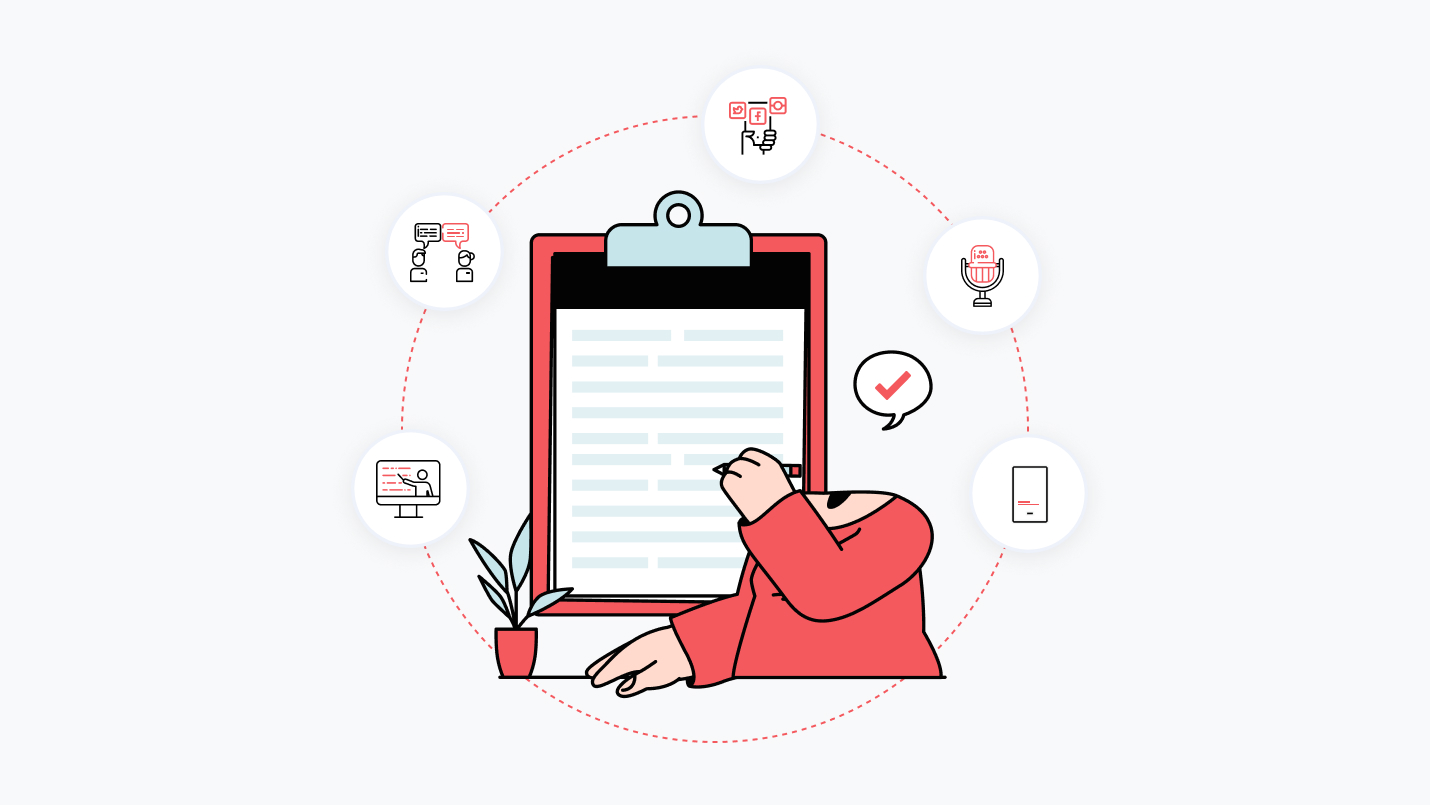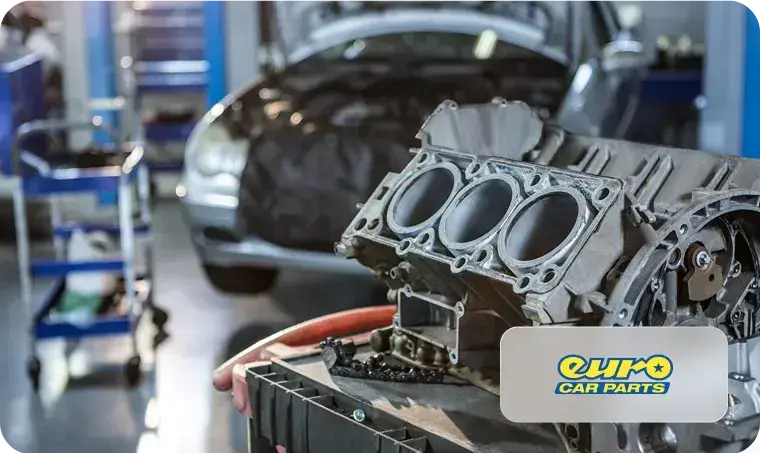As we lead into 2025, eCommerce leaders are looking to headless commerce to help increase conversions, engagement, and business growth.
It is estimated that eCommerce sales will exceed $6.3 trillion by the end of 2024, with 73% of sales on mobile devices and a nearly 70% cart abandonment rate, according to Gitnux. Clearly, something needs to change to increase conversion rates on mobile and capture new areas of the market, including social commerce, which alone will reach $605 billion by 2027.
Headless commerce provides brands with the ability to fine-tune their shopping experiences for each digital touchpoint, improving the customer experience and critical KPIs in the process. In this guide, we will:
- Introduce you to headless commerce
- Explore how headless commerce is helping brands succeed
- Lay out critical steps in a headless commerce strategy
- Explore the latest trends in headless to help you prepare for success
What is Headless Commerce?
Headless commerce refers to using decoupled commerce infrastructure, where the front-end(s) (the storefronts or user interfaces) are separated from the backend systems that operate the store, a separation that introduces more possibilities to customize customer experiences.
When we talk about decoupling, this refers to commerce infrastructure that is no longer tightly bound into one codebase and system (this is ‘traditional’ or ‘monolith’ commerce infrastructure), but instead can visually be represented as follows:
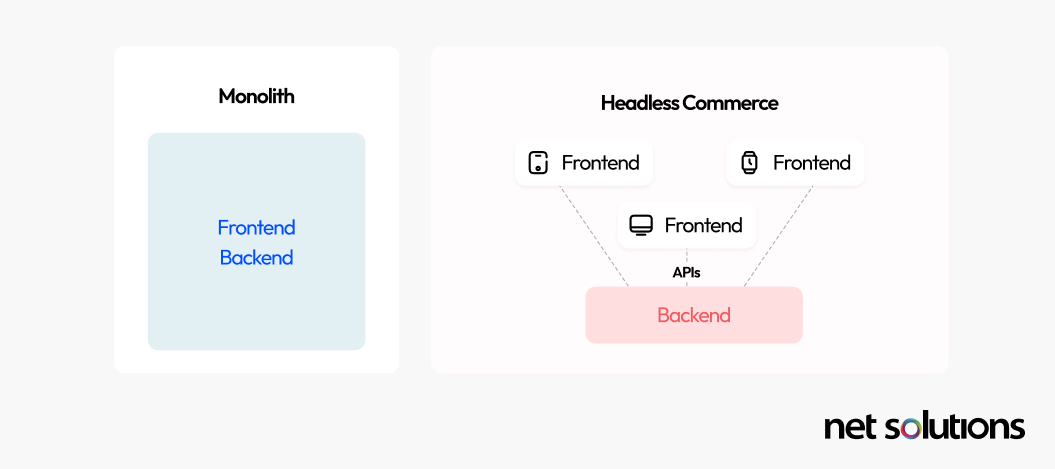
With this separation, brands can create independent front-ends, using frameworks and languages for each front-end, but more specifically creating a user interface that best suits that digital touchpoint. Because how a shopper navigates their buying journey on a website is not the same on a smaller mobile device, and definitely not the same on social media.
What are the Key Components of Headless Commerce?
Before we move on to exploring the benefits of headless commerce, let’s break down what headless commerce architecture or infrastructure looks like.
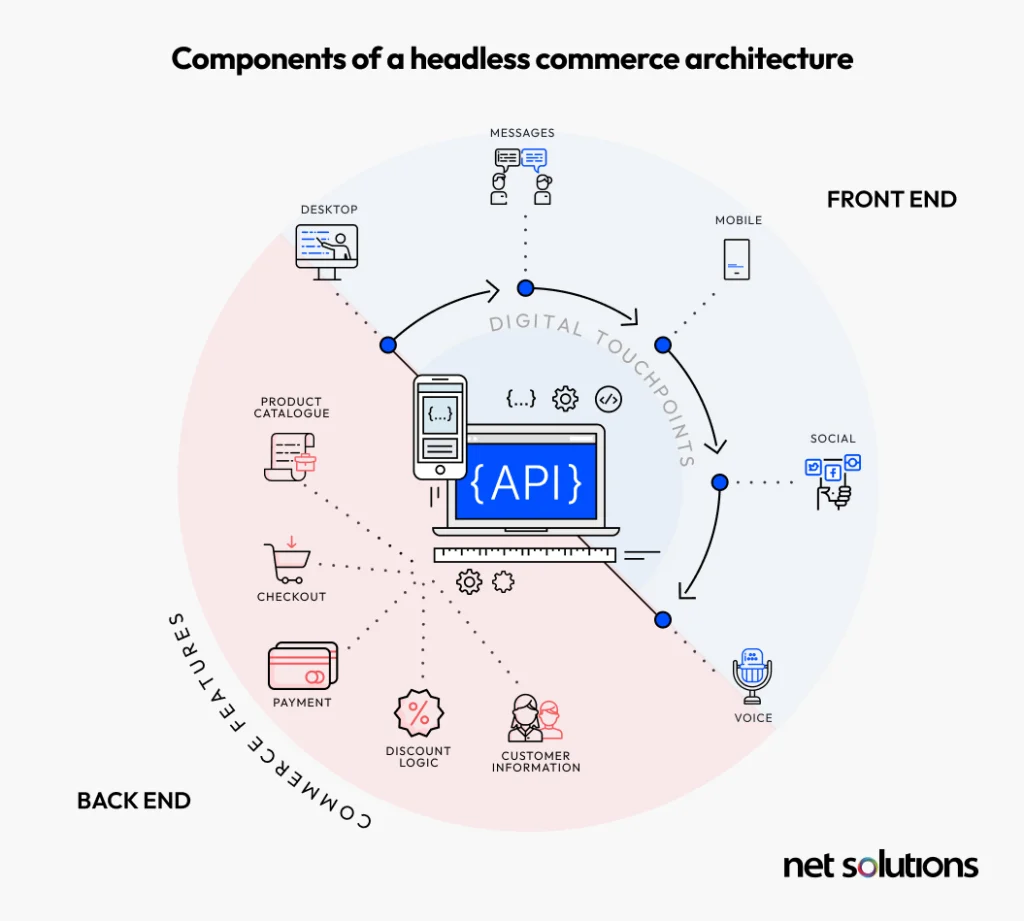
The key components of headless commerce architecture include:
- Back-End: The business logic powering commerce features, including the database and servers that manage inventory, save customer information, process orders through to delivery, and more.
- APIs (Application Programming Interfaces): A conduit that sends data between front-ends and the back-end, or between components of the back-end. Because the API connects these two independent points, they don’t need to be written in the same languages or using the same frameworks.
- Front-End(s): The one or more front-ends you have developed, each with its own unique user interface and elements designed for that specific channel and/or device, e.g., standard website, mobile app(s), social media, IoT.
However, this is a very simplified view of headless architecture. In reality, headless architecture looks more like this:
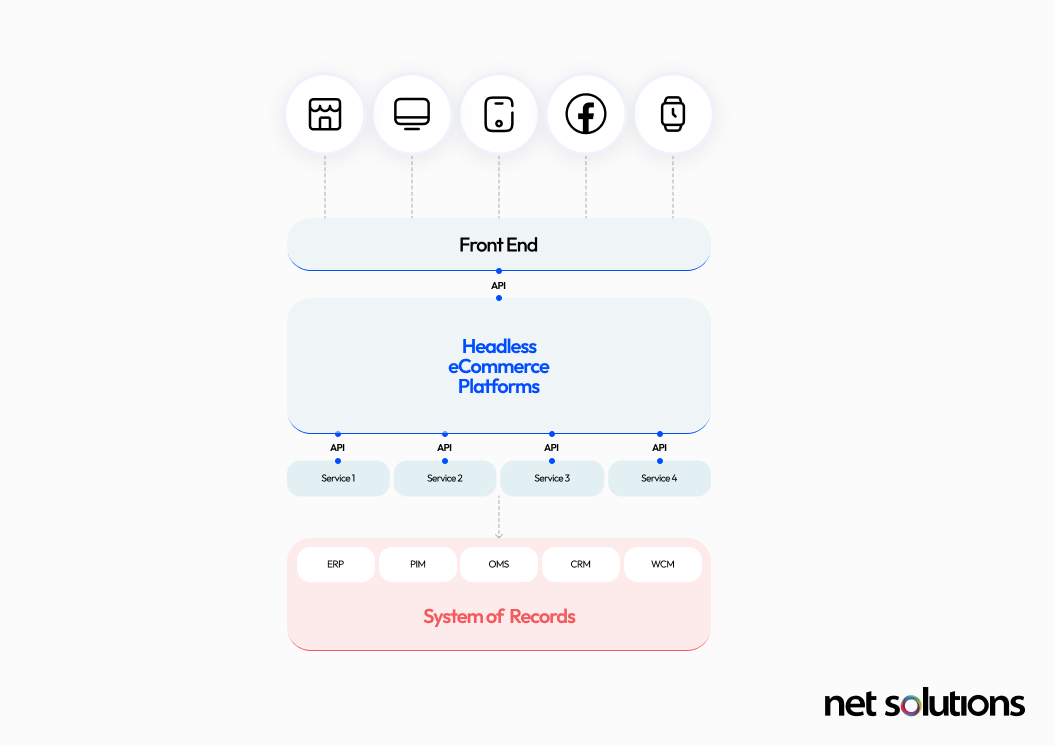
This more complex view takes into account the following additions to the back-end:
- Microservices: Those services which alter the functions or capabilities of the core platform, connected via API.
- Systems of record: Connections to other systems of record, including ERP, PIM, CMS.
What Are the Challenges of Traditional Commerce Platforms?
Why did headless commerce emerge? Primarily because traditional commerce could no longer keep pace with change. Let’s explore what we mean by that, exploring the challenges of traditional commerce and how the benefits of headless commerce can overcome those challenges.
1. Limited flexibility in front-end customization
The first change that traditional commerce could not handle was the expanding number of ways that customers shop online. In fact, the average buyer will engage with 8-10 channels during their purchase journey, including website, mobile app, online portal, and social media, according to the 6th State of the Connected Customer report. But the same report showed that consumers’ top frustration is disconnected experiences—and that’s because traditional commerce platforms can’t deliver differentiated experiences, they can only deliver one fixed experience. Even if that experience is mobile-responsive, it cannot compare with the level of experience of a mobile app. As a stopgap, some organizations were duplicating their commerce infrastructure for each new digital channel, resulting in fragmentation and inefficient resource use.
Headless solution: By uncoupling the front and back-ends, you have one back-end that can serve as the foundation for an infinite number of front-ends. This means that you always keep in sync, no matter how many channels you support, and that you have the freedom to choose the languages, frameworks, and user interfaces that are optimal for each digital touchpoint.
2. Scaling difficulties
Any kind of monolithic software inevitably suffers from performance degradation and scaling difficulties as traffic increases, operations become more complex, or the business grows. Large software code bases become unwieldy, on the one hand, and any hiccup threatens taking the whole system down (because it’s tightly bound). New innovations only increase these challenges, making traditional systems more complex and subject to performance issues.
Headless solution: Headless commerce supports both vertical and horizontal scaling. Decoupling the system allows for leaner front-ends, more capable of being nimble to growth in traffic. Furthermore, front-ends are limitless, allowing horizontal scaling to new regions, markets, or business segments, all managed from the same central system. As the business scales with new services or capabilities (innovations), these can be connected by API (microservices), with independent scaling capacity to handle loads.
3. Slow time-to-market
While it may appear simpler to manage only a single commerce system, the reality is a significant IT resource requirement to integrate new features, which all need to be tightly bound into the system. Furthermore, the interdependencies in the system mean that new features need to be carefully planned and tested to ensure the entire system continues to work as expected and that updates happen in a time that is not disruptive to performance, all of which delays time-to-market for new campaigns, products, or features.
Headless solution: The separation of the front- and back-ends allows development teams to work independently on each part of the system, adding new features to the front-end without impacting the back-end or making changes to the back-end that then automatically service all front-ends. New features or services can also be easily added via API, requiring less custom work to launch. The result is an accelerated development time.
4. Lack of personalized and omnichannel experiences
Omnichannel retailing is the capacity to offer a fluid experience as you move across channels—and, perhaps more important, the capacity to personalize those experiences. Traditional commerce platforms are tightly coupled, so you get one experience served one way through a limited number of channels. The need to serve multiple channels persisted, so traditional commerce retailers managed sales across channels using duplicate systems, the result of which led to a fragmentation in experience, inventory management, and customer service.
Headless solution: Headless commerce architecture is designed to deliver a consistent experience across any touchpoint (meeting omnichannel goals) and to differentiate those experiences in response to user history or behavior. This means that if you put an item in your cart on a social channel and switch to the web, it will still be there. But if you leave it there for a while, you may be offered an incentive to encourage conversion. That’s omnichannel retailing and personalization at work.
5. Incorporating third-party tools
Traditional commerce platforms come with built-in features and some optional integrations, but anything else would require custom integrations to the code base, at significant time and cost. Further, if tools are coded in different languages, this can prohibit integration. This is particularly true for the latest innovations, requiring layers of work to code into areas of the system and resulting in a very messy and error-prone situation.
Headless solution: Headless commerce solutions are API-first, exposing the entire commerce infrastructure to add services with APIs, a much more straightforward approach to integration. Further, APIs remove the requirement for systems to be the same, allowing you to integrate all your systems of record and third-party tools.
These are just some of the many differences we explore between traditional vs headless commerce.
What to Consider When Adopting a Headless Commerce Strategy
The following are things you should think about before adopting a headless commerce strategy—some may call these ‘challenges,’ but we like to think of them as just the cost of unlocking new levels of business growth.
1. Higher upfront costs and complexity
Switching to headless will require an investment to move your site and more up-front technical knowledge to manage the switch, develop the new architecture (back-end, front-ends, APIs, integrations).
2. Increased resource requirements
Managing the intricacies of decoupled systems will require an upfront investment in planning and ongoing management of APIs, front-ends, and integrations. The results often offset these outlays.
3. Development team expertise
Your existing IT team may not have the skills or experience working with headless architecture or the specific system that best meets your needs or the front-ends you have chosen, requiring hiring, training, or outsourcing to fill these gaps in the short or long term.
4. Plan for continuous improvements
Moving to headless is a strategic commitment to continuous improvement, remaining agile to new innovations or channel opportunities, requiring ongoing resources for business strategy and development.
How to Create an Effective Headless Commerce Strategy?
If you are ready to switch replatform your eCommerce business to leverage a headless commerce strategy, we recommend the following process:
1. Determine your business goals and objectives
Gather together all the relevant stakeholders who should have a say on the commerce strategy (IT, marketing, sales, C-suite) and understand what their individual goals are and how they align with the business strategy. This step should establish your current state against a desired future state, defined in business terms. This means understanding what KPIs (e.g., business growth, experience goals) you want to drive and how your commerce strategy impacts those.
As with any digital transformation, deciding on headless right away is a technology-driven initiative. You will achieve a higher level of success if the choice in approach is driven by aligning with business goals.
2. Conduct a tech stack audit
Assess existing systems to determine:
- All technology in the stack: platform, servers, storage, integrations, custom code, etc.
- Evaluating systems: capacity, performance, technical debt, security, SEO, highlighting any pain points, misconfigurations, legacy software, or inefficiencies.
- Baseline KPIs: If your goals are around business growth or experience, you need to include baselining those KPIs to accurately capture your ‘before’ state.
3. Choose the right architecture, platform, and tools
Your eCommerce strategy will need to establish the functional and non-functional requirements for a new potential platform, which includes understanding which features you need or want, security considerations, usability considerations, even language preferences of your IT team. All of this goes into helping you choose the following:
- Architecture: traditional (likely ruled out at this point), headless or composable. Understand which is the right approach for you.
- eCommerce platform: the specific eCommerce platform to support that architecture based on your needs. If you’re confident in headless, we have a list of our top headless commerce platforms (and another list of B2B headless commerce platforms). Evaluation points may consider the licensing model, problem-solution fit, specific features, the partner ecosystem, and more.
- Front-end technologies: To pursue a headless strategy, you likely have several digital touchpoints in mind. Define which front-end technologies align with your needs.
- Integrations: Determine needed integrations with systems of record (e.g., CMS, ERP) and which third-party tools you need to replace or want to use (e.g., payment gateways, personalization tools).
4. Assemble your development team
Establish a plan for migration, including a comprehensive requirements document (backlog). This document will help guide development priorities and determine what kind of team you need to assemble. Likely, that team will include experts in replatforming (safely moving data from one commerce system to another), back-end commerce architecture, front-end development, API management, microservices knowledge, and user experience design.
If you haven’t already, now is a good time to bring on an experienced partner to guide the new effort or to assist in-house teams with execution. Most clients we work with are able to identify earlier in the process that they lack both the experience and the bandwidth to replatform, giving us the opportunity to lend our expertise to the entire commerce strategy development process.
5. Execute, test, launch, and iterate
Execute on all aspects of the project (design, development, migration, integrations), with incremental and full testing before launch. Test for and optimize the user experience, audit SEO, security, and performance. Continuously refine based on metrics and feedback.
Examples of Successful Headless Commerce Implementations
Euro Car Parts Boosts Revenue by 2300% (in 5 years) After Replatforming
As a partner in architecting and managing Euro Car Parts’ commerce infrastructure, Net Solutions has played a pivotal role in the continued evolution of the commerce capabilities of the UK’s leading distributor of car parts. Since 2009, Net Solutions has helped bring to life a series of digital properties and apps for Euro Car Parts, all based on a custom implementation of Magento. Over time, it was clear that existing infrastructure was accruing technical debt and performance issues and a decision was made to headless infrastructure with Adobe Commerce.

Hancocks synchronizes channels with shift to Adobe Commerce
Hancocks is the UK’s largest confectionery wholesaler, serving more than 25,000 independent retailers with 14 cash and carry stores and an online channel that supports a quarter of its business. As Hancocks scaled its business, it also began to outgrow the capabilities of Magento. After looking at various headless solutions, Hancocks also chose Adobe Commerce, re-launching its B2B website and new channel experiences for mobile. Among notable results has been a 96% increase in app conversions.
Headless Commerce Trends to Look Out For
The future of eCommerce continues to shift in response to new technologies and innovations. We have seen a significant amount of innovation within the headless space, most notably across the following trends:
AI and Machine Learning
A significant number of headless platforms are integrating AI tools directly into the platform or as composable service add-ons. The application of AI may vary across platforms, but most notably supports the following:
- Personalization of customer journey: product recommendations, chatbots, retention and loyalty campaigns, advanced search.
- Automation of routine tasks: reducing manual effort and improving efficiency.
- Intelligent analytics: leveraging data-driven insights for better decision-making.
- Supply chain optimization: improving logistics and inventory management.
Higher Demand for Personalization and Real-Time Data
With the increased availability and use of AI, consumers are now demanding a higher level of personalization across both B2C and B2B scenarios. Omnichannel retailing leverages real-time data (browsing behavior and purchase history) to create consistent and personalized experiences across channels.
Personalization can include:
- Product recommendations: dynamically adjusting based on user behavior.
- Search and product discovery: improving relevancy and user experience.
- Customer-specific pricing or marketing deals: presenting deals when an item is left in the cart.
- Industry-specific products & content filtering: website and catalog personalization for B2B.
- Omnichannel orchestration: creating a seamless customer journey across multiple touchpoints.
IoT and Voice Commerce
There has been a growth in wearable technology and the use of wearable technology for commerce, a trend known as voice shopping or voice commerce. This has been fueled, in part, by voice commerce and the growing trend toward using spoken commands to interact with a growing number of devices (watches, fridges, home pods) and perform increasingly complex commands such as “add soap to my grocery list” or “find me the best deal on winter jackets.”
Composable Commerce
9 out of 10 of our most recommended headless commerce platforms are now composable, either by design or through progression. There is a subtle difference in approach, as those by design treat all commerce platform capabilities as composable services, while those that have moved toward composability are wrapping a core headless engine with additional composable services. Regardless, this is a trend we expect all headless platforms to move toward. Learn more about composable commerce vs headless commerce.
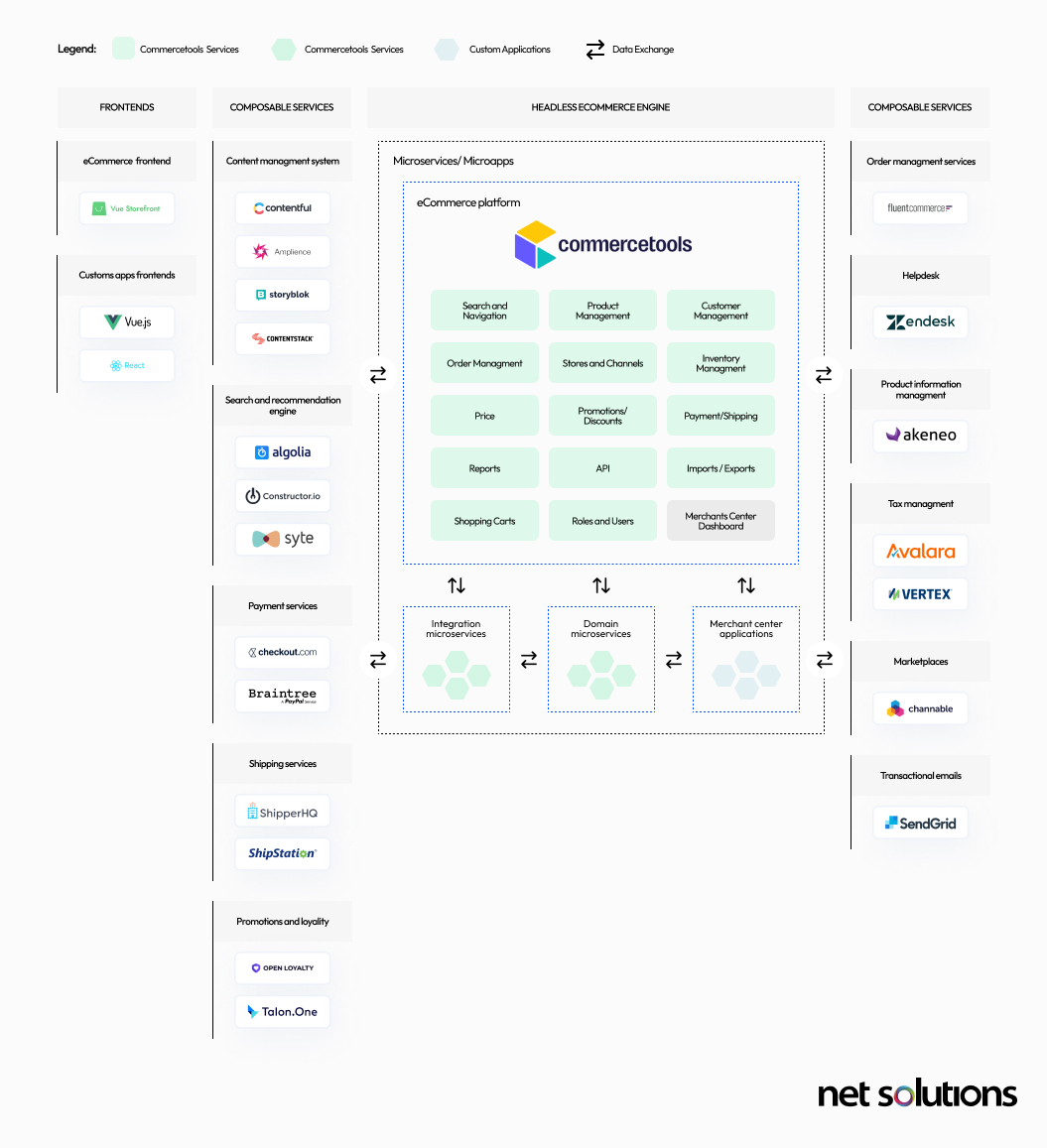
Social commerce
Social commerce is anticipated to reach $6.2 trillion by 2030, according to Intelligent Research, a channel that brands are exploring with the help of headless platforms. This area is continuing to see innovation, with live interactive shopping streams, the ability to ‘try on’ makeup using AR directly within Snapchat, or gamified experiences that boost engagement to close the sale. Social commerce has introduced new levels of ‘fun’ and interactivity, setting the bar high for newcomers.
Ready To Embark On Your Headless Commerce Journey?
If you are experiencing high levels of growth, face steep competition, or are growing more than your system can handle, it’s time to consider a switch to headless commerce.
As an award-winning eCommerce development agency with over 15 years experience, we know that eCommerce success requires a deep understanding of customer needs and the latest innovations in commerce technology. At Net Solutions, have helped midsize to large global brands realize the benefits of switching to headless commerce, with services that start at strategy and take you right through to optimization and ongoing support.
Frequently Asked Questions (FAQs)
How does headless commerce work?
Headless commerce refers to commerce architecture that separates the front-end user interface (the website, app, etc.) from the functional back-end, allowing brands to create more customized and personalized front-end experiences and integrate with a wider variety of tools using APIs, regardless of their language or framework.
What are the benefits of adopting a headless commerce strategy?
The benefits of headless commerce include increased agility to new technologies or channel options, a greater level of personalization per digital touchpoint, greater technical flexibility to integrate with third-party tools or systems of record, and increased scalability and performance.
What businesses benefit the most from headless commerce?
Headless commerce is ideally suited to mid to large B2C and B2B businesses that are focused on omnichannel retailing and who have the internal resources to manage a more complex technology stack (internal staff or willingness to partner for success). Large retailers, fast-growing brands, highly competitive marketplaces, complex business models, and large catalogs are all well supported by headless commerce.
How does headless commerce support omnichannel retail?
Headless commerce separates the back-end from the front-end experiences, allowing an infinite number of front-ends to all interact with the same core back-end, ensuring that customers see real-time information regardless of where they interact with you and that their experience moves fluidly across websites, mobile apps, social commerce, and more.

